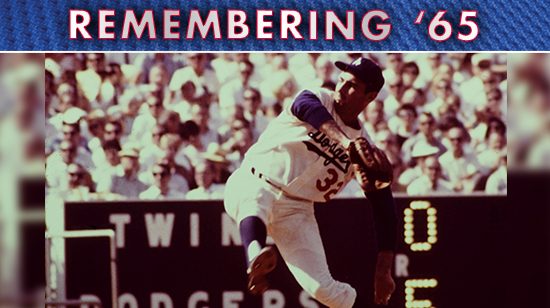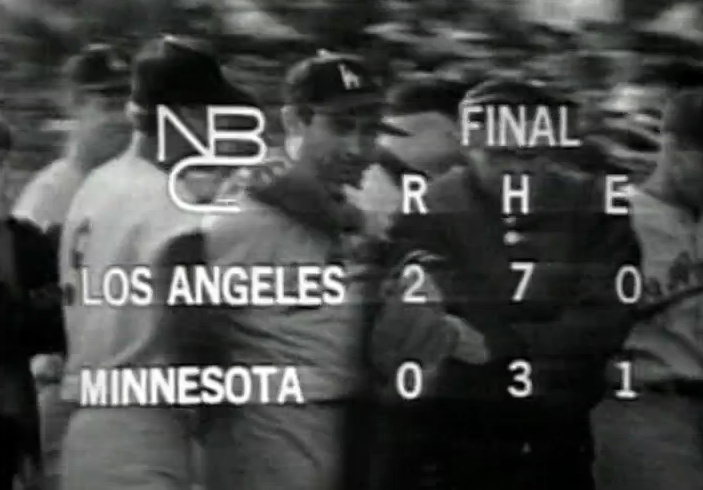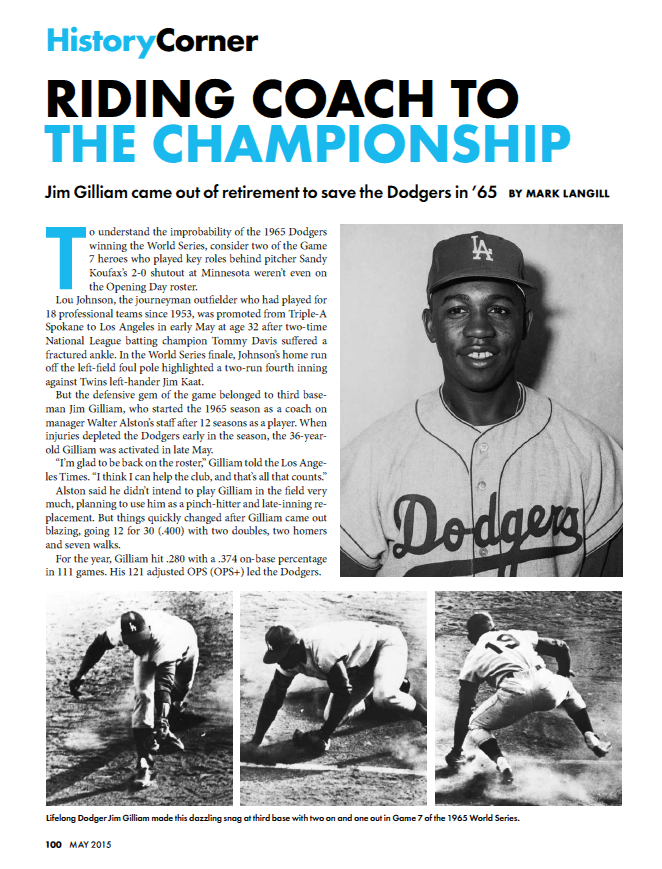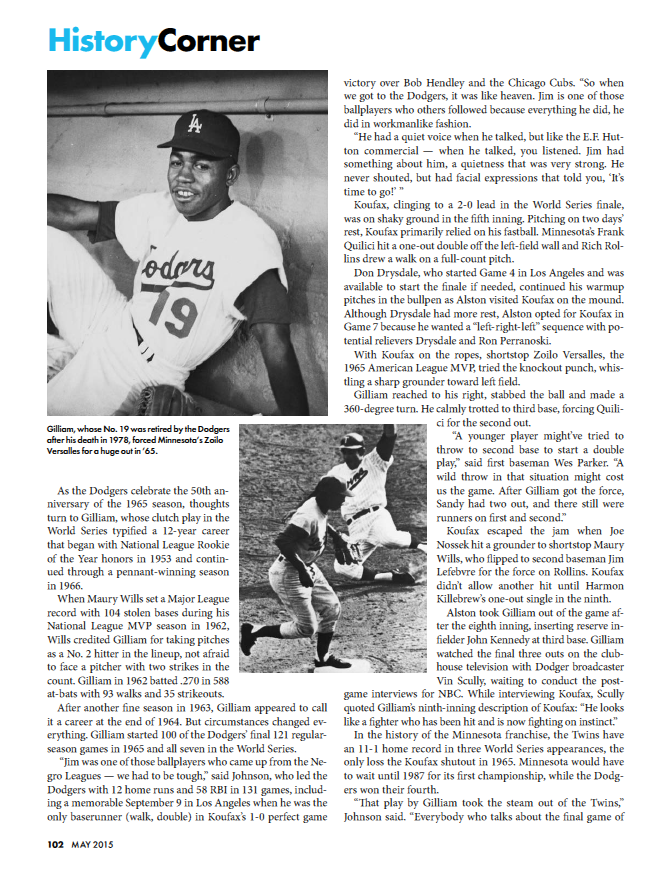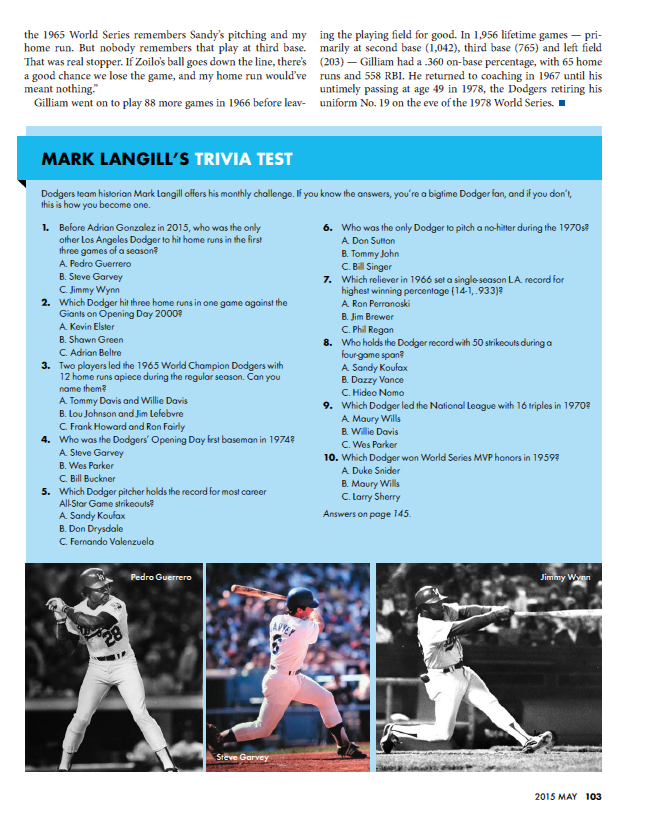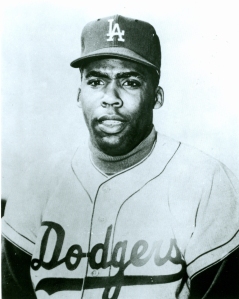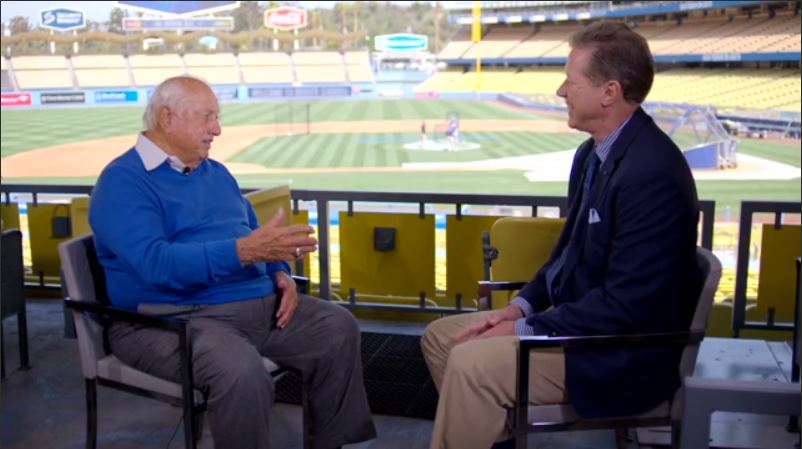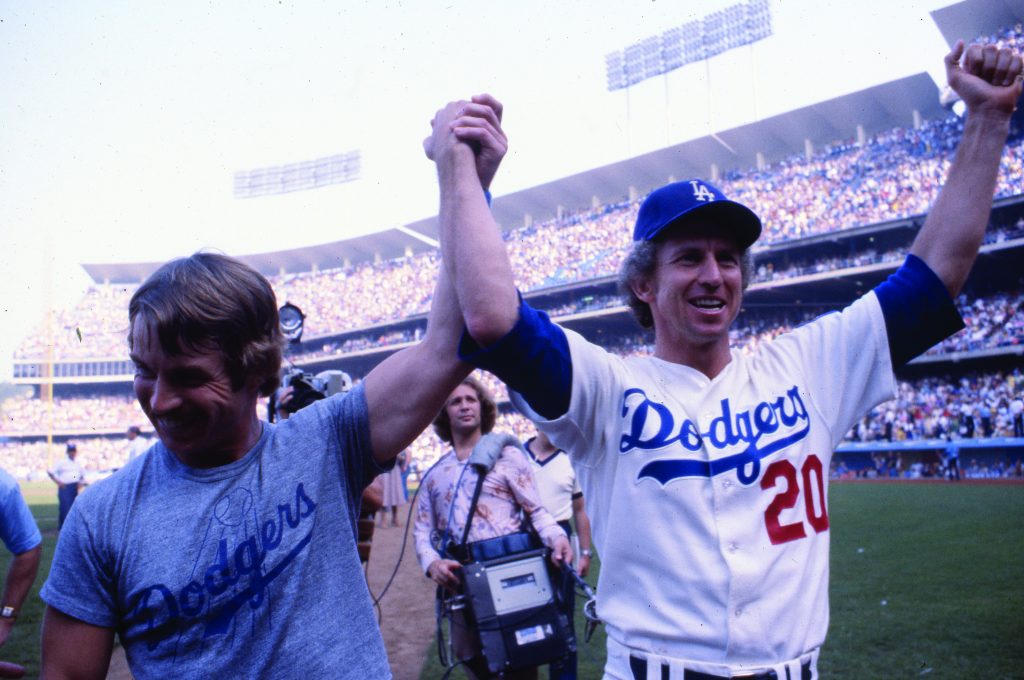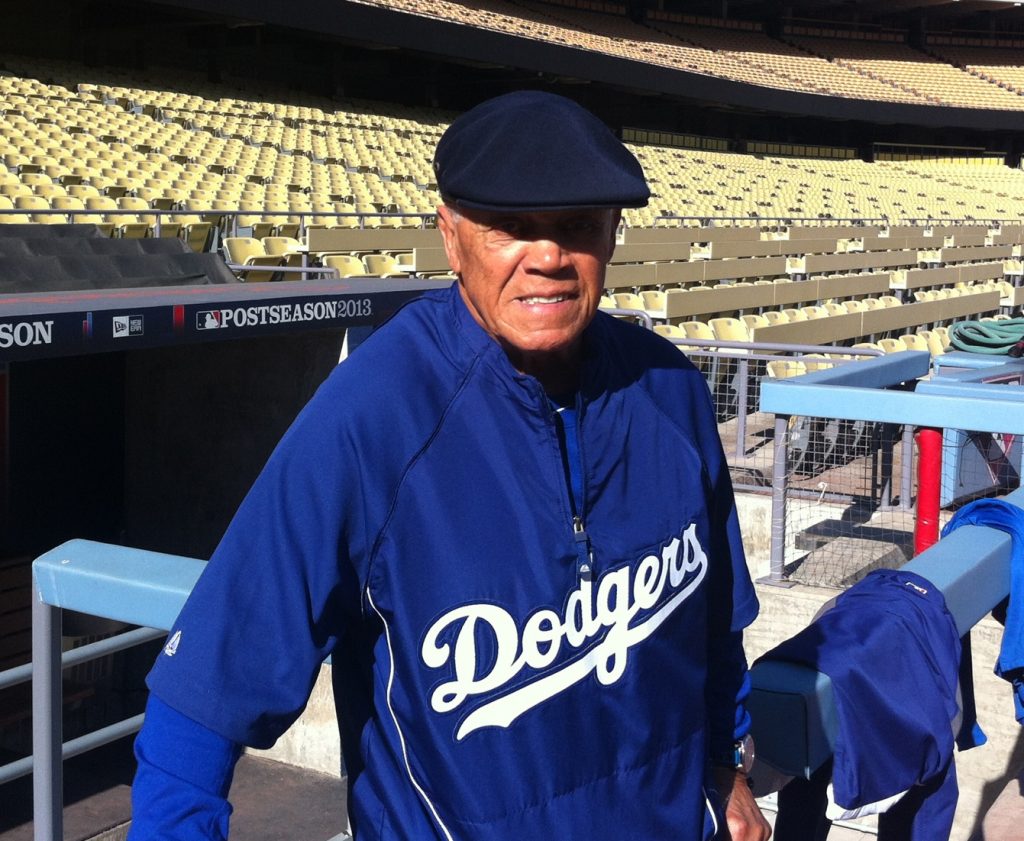As I mentioned a couple days ago, on July 14 I made my second visit to Cooperstown, and first as an adult. I took tons of pictures, and couldn’t help wanting to share some with you. Today, here is a set of shots focusing on the Dodgers, dating from their move to Los Angeles.
Tag: Walter Alston
Above is the page from the 1954 Dodger Yearbook introducing Brooklyn’s new manager, 42-year-old Walter Alston. In honor of Alston’s No. 24 being tonight’s incarnation of the Retired Numbers Pin Series giveaways at Dodger Stadium, click below for a 2014 piece from Dodger Insider magazine celebrating the Hall of Fame manager.
— Jon Weisman
By Jon Weisman
With the Dodgers celebrating their 10 retired numbers in a pin series this year, I was curious who was the last active player to take the field with each of these legends. Here’s what I found:
1 Pee Wee Reese
Ron Fairly, who was 19 when making his debut with the 40-year-old Reese as a teammate on the 1958 “Welcome to Los Angeles” Dodgers, was 40 himself when he played his last big-league game in 1978. Years between Reese’s first game and Fairly’s last: 38
Koufax. Johnson. Championship.
This is the last tale from “Remembering ’65,” and the one you know the best.
Fifty years ago today, working on two days’ rest in Minnesota, backed by Sweet Lou Johnson’s fourth-inning home run, Sandy Koufax pitched a 2-0 shutout over the Twins to give the Dodgers the 1965 World Series title, their fourth in the past 11 seasons.
“Alston Leans to Left and Koufax Proves He’s Right,” read the headline in the Times, regarding Dodger manager Walter Alston’s decision to start Koufax over Don Drysdale. But that result was anything but a given as the game unfolded.
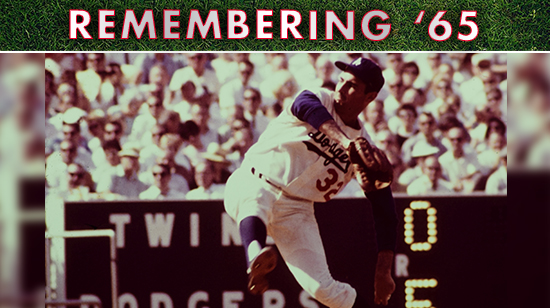
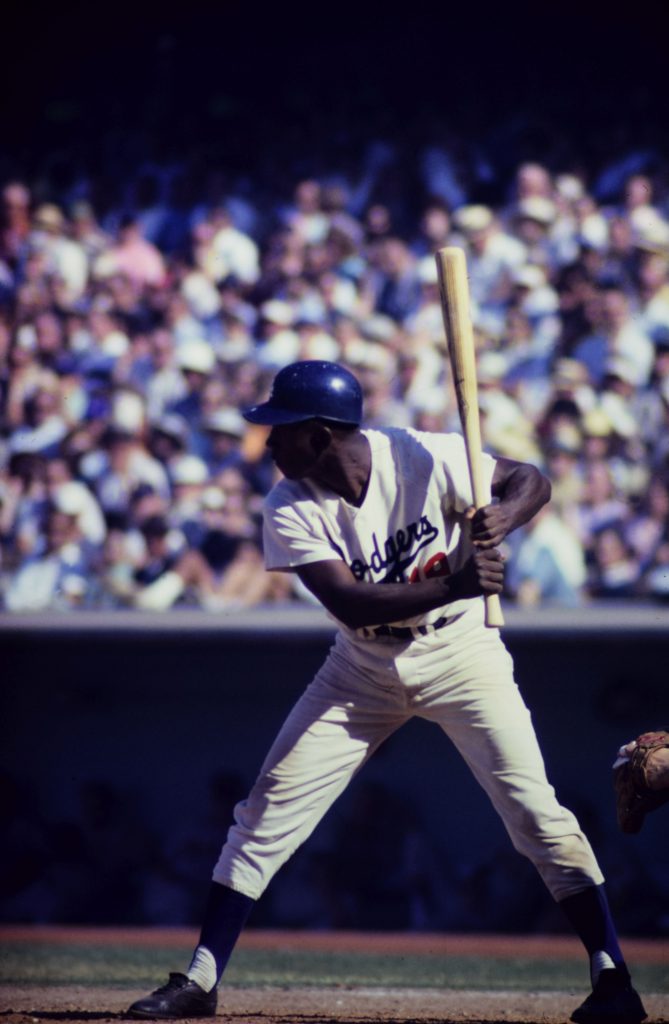 Fifty years ago today, the Dodgers activated retired third-base coach Jim Gilliam to return to the field.
Fifty years ago today, the Dodgers activated retired third-base coach Jim Gilliam to return to the field.
“The old pro is back,” Walter Alston told the Times.
Though he had been a full-time coach, Gilliam had been taking batting and infield practice since Spring Training.
“I’m glad to be back on the roster,” he said. “I think I can help the club, and that’s all that counts.
Alston cautioned that he didn’t “intend to play Jim at third base very much, but there will be times when he will finish up the game there after pinch-hitting.”
That plan lasted for about three days. The 36-year-old Gilliam played 16 innings across a May 31 doubleheader and went on to start 99 more games during the remainder of the 1965 season and all seven in the ’65 World Series.
In a story that appeared in Dodger Insider magazine this month, Mark Langill offers a fond look back at how Gilliam’s improbable comeback boosted the Dodgers to a title. (Click each page below to enlarge.)
— Jon Weisman
By Jon Weisman
The 1965 Dodgers spent the last 28 days of May in first place — including Memorial Day, May 31, when 50,997 at Dodger Stadium saw the Dodgers and Reds split a doubleheader — but it was hardly an uneventful month. Here’s a word album of what was happening 50 years ago …
By Jon Weisman
Periodically this year at Dodger Insider, we’ll flash back to 1965 to celebrate the 50th anniversary of that World Series title for the Dodgers. You all know how it ended, but do you remember how we got there?
Today, we’ll check in on how things were sounding from Dodgertown in Vero Beach. Opening Day 1965 on April 12 was still about two weeks away, so while the Dodgers were coming off an 80-82, sixth-place finish in 1964, Spring Training’s power of positive thinking was in full swing. This was particularly the case with the pitching staff, as evidenced by two pieces that ran in the Times’ editions on March 28, 1965.
Dodger catcher John Roseboro, entering his ninth season, told beat writer Frank Finch of the Times that the 1965 pitching staff was the best he’s handled.
“We have an overabundance of left-handers,” Roseboro said, implicitly acknowledging the offseason trade of Frank Howard for Claude Osteen, who joined Sandy Koufax and Johnny Podres in the four-man rotation, “but we have more depth now and won’t have to depend on two starters (Don Drysdale and Koufax) like we did most of last year.”
Drysdale threw 321 1/3 innings across 40 starts in 1964. Koufax averaged 7.9 innings per start with a 1.76 ERA, but his 1964 season after a 13-strikeout shutout August 16.
Assessing those top two pitchers in the midst of exhibition play, Roseboro was upbeat even if his glasses weren’t entirely rose-colored.
“Sandy’s just about ready to go nine strong innings. He’s throwing well, but his control is off a bit,” Roseboro said. “The last time I caught Don he looked ready for nine. Then he hit the ‘dead arm’ stage against the A’s. His control is good.”
Times columnist Sid Ziff reported even more positivity about the pitching, with a Dodger spokesman telling him it was “by far” the best it had ever been in Los Angeles. Of bigger concern was addressing 1964’s defensive shortcomings. The spokesman didn’t mince words.
“Our defense was horrible last year, but John Kennedy and Jim Lefebvre will help to correct that situation,” he said. “If Lefebvre doesn’t stay with the club, shame on us. There was a rumor he might be farmed out for another year of experience.”
Lefebvre made his Major League debut on Opening Day and went on to play 157 games and win the National League Rookie of the Year award. (Coincidentally, 50 years ago today, it was reported Lefebvre had escaped injury after being beaned in the helmet during an exhibition game against Detroit by former Dodger pitcher Larry Sherry.)
“We aren’t set in right field yet,” the spokesman continued, “but no matter who plays there, he’ll be a defensive improvement over Frank Howard. The way it looks now, Wes Parker has the best shot at it. He looks like a real hitter.”
Parker ended up settled at first base, with Ron Fairly taking the bulk of right-field action.
Also of concern was the clubhouse atmosphere and perceived undermining of manager Walter Alston. Leo Durocher, in particular, was famous for challenging Alston’s authority.
“Alston is finally on his own as a manager,” said the spokesman (who Ziff said wanted “to remain unidentified because it wouldn’t do for him to show so much confidence.”) “Now he doesn’t have to defer, subconsciously or otherwise, to any of his coaches. … The Bragans, Dressens and Durochers are all gone. There’ll be no other ‘managers’ in the dugout this season. We think it has taken a load off Alston’s shoulders. He has already assumed more authority.”
The idea that Alston, only one season removed from his third World Series title, was so under the gun shows you that it never really gets easy for a manager. But 1965 would indeed prove rewarding for Smokey.
A few days ago at Fangraphs, Miles Wray wrote about the five greatest pitching performances of 2014 that came in a loss. I thought I’d put a Dodger twist on this, and throw in some historical perspective as well.
Here are the five greatest pitching performances during a loss in Los Angeles Dodger history, dating back to 1958 and using, as Wray did, Win Probability Added as the measurement. Continue past the five for a couple of bonus epics, including one that will make your jaw drop …
By Jon Weisman
You can’t deny that Tommy Lasorda is a storyteller like no other.
In his life-spanning interview for SportsNet LA’s “Connected With … Tommy Lasorda,” which premieres tonight at 8 p.m., Lasorda spins some of his favorites, starting with his childhood.
“I worked on the railroad when I was 15 years old,” Lasorda said. “I did a man’s job. I worked 10 hours a day, 55 cents an hour. Now I told ’em I was 18, but they kept saying, ‘You’ve got to show us proof that you’re 18,’ and I told them that the church that I was baptized in burned down and the birth certificates were no longer there. I kept getting them off, getting them off, until my father said, ‘Wait a minute — your brother Tommy’ — I had a brother prior to me, he was 2 years old and he died, and he was born in 1925. I’m born in 1927. I take his birth certificate. Now all of a sudden I’m 18 years old.”
[mlbvideo id=”31365675″ width=”550″ height=”308″ /]
By Jon Weisman
Notes from a Saturday in the park …
- Dylan Hernandez of the Times and Ken Gurnick of MLB.com have pieces on Carl Crawford’s physical status. From Hernandez:
… Living in Arizona over the winter, Crawford addressed his health problems by spending a significant part of his off-season at the Dodgers’ spring-training complex. Under the supervision of Dodgers trainers, he worked to strengthen his core and back.
Crawford, who was a four-time American League stolen-base champion with the Tampa Bay Rays, intends to become a threat on the basepaths again.
“I really want to run,” he said. “I got gun shy last season because any time I stole a base, I had pain. I know I can steal 25 bases. It’s frustrating when I’m stealing 10 or 11. I do everything else fast. I still run down balls in the outfield, I still get triples, I still go first to third, so it’s frustrating I don’t steal more bases.” …
- Because the Dodger pitchers got their one off day from Spring Training today, Dodger catchers had a precious day to focus on hitting, notes Gurnick. “Being a catcher, sometimes you’re unavailable to get in the quality swings other position players get,” A.J. Ellis said.
- Miguel Rojas discussed the challenges of transitioning from shortstop to second base — keeping Alex Guerrero in mind — with J.P. Hoornstra of the Daily News.
- Mark Saxon of ESPN Los Angeles writes about the comfort zone for Cuban Dodgers Yasiel Puig, Alex Guerrero and Onelki Garcia, who locker side-by-side-by-side.
- Aaron Harang, one of the Spring Training starting pitchers with the Dodgers a year ago, has just signed a minor-league deal with Cleveland and will compete for a spot in the Indians’ rotation, reports Paul Hoynes of the Cleveland Plain-Dealer.
- Another 1961 Dodger artifact comes from Ernest Reyes of Blue Heaven, featuring Walter Alston. Definitely worth the click.
- Mark Mulder, whose Paco Rodriguez-inspired comeback after more than five years away from the majors looked like it might be the story of the year in baseball, saw that hope end when he ruptured his left Achilles’ tendon in an agility drill before his first bullpen session for the Angels, writes Mike DiGiovanna of the Times.
I can handle this. But seeing my son in tears when he saw me in a boot and crutches and I told him I wasn’t going to pitch. That was tough.
— Mark Mulder (@markmulder20) February 15, 2014
By Jon Weisman
Ahead of Wednesday’s announcement of the National Baseball Hall of Fame balloting, some Dodger-related trivia from the past three decades …
In the past 10 years, only one man has been elected to the the Hall of Fame who played in a Dodger uniform: Rickey Henderson in 2009. Greg Maddux, Mike Piazza, Fred McGriff, Jeff Kent, Luis Gonzalez, Paul Lo Duca, Hideo Nomo and Eric Gagne are eligible to end that drought. (Joe Torre, whom the Expansion Era Committee elected to the Hall in December, will be the first Dodger manager entering the Hall since Tommy Lasorda.)
There were more ex-Dodger players entering the Hall of Fame in 2003 then the past 10 years combined: Eddie Murray and Gary Carter.
The last player to have a Dodger cap on his Hall of Fame plaque was Don Sutton, elected in 1998. You then have to go back to Don Drysdale in 1984 to find another longtime Dodger joining the Hall via election by the Baseball Writers Association of America, the same year that the Veterans Committee tapped Pee Wee Reese.
One late cup-of-coffee Dodger who made the Hall was Jim Bunning, chosen by the Veterans Committee in 1996. Bunning had a 3.36 ERA in nine games for the Dodgers in 1969 at age 37.
Hoyt Wilhelm, elected to the Hall in 1985, finished his career as a Dodger in 1972, 16 days shy of his 50th birthday. He was preceded by short-time Dodgers Juan Marichal in 1983 and Frank Robinson in 1982.
Swinging back to managers, the Veterans’ Committee put Walter Alston in the Hall in 1983, Leo Durocher in 1994, Ned Hanlon in 1996 and Lasorda in 1997. The Hall doors opened for former Dodger owner Walter O’Malley in 2008.
The results of this year’s BBWAA Hall of Fame balloting will be announced on MLB Network and MLB.com on Wednesday at 11 a.m.
By Jon Weisman
“I got a newspaper and in the article, Ty Cobb was quoted as saying, ‘I like the way that kid slides,’ talking about me. And it just lifted me up.”
– Maury Wills
At the start Sunday of the Dodgers’ seventh annual Winter Development Program at Dodger Stadium, legendary shortstop Maury Wills was the guest speaker. In a subsequent interview, the great-natured Wills shared what he had to say to the aspiring Dodgers, along with other memories.
“I had a message in mind when I was getting dressed this morning, I had a message in mind when I was driving (to the stadium) … (but) I just took it off the top of my head. It’s the same way when you’re on the field — you practice, practice, go through all the rudiments, the fundamentals of catching the ball, throwing the ball, running the bases, and with 60,000 people in the stands, you forget it. It just comes. Everything just comes natural. So I just got up and started talking.
“I kind of reflected on where I came from, where I was born and raised. I have a philosophy that the true measure of success might not be how far you went, but from how far you came. So I let them know that. I grew up in the projects, Washington D.C., one of 13 children — eight sisters, four brothers. One bath in the house, one door to the house, the projects — that’s public housing. No future whatsoever.
“One day, a major-league player came to the clinic, (and) by the time he left, I had a direction for the first time. When they signed me, the Dodgers, in 1950 — what’s this, 2014? I’m still here, living my dream. And if you can live your dream, you never have to work a day in your life, and that’s the way it’s been for me. So anyway, that player, he was white — in those days, people didn’t interact as we are today — we didn’t know where he had come from. He was from the Washington Senators, second baseman — actually from Pasadena. (Ed. note: this appears to have been Jerry Priddy.) No one had ever heard of Pasadena. We couldn’t understand where he came from, but by the time he left, for the first time in my life, I had a direction. I knew I didn’t have to grow up and live in these projects and marry one of the girls in the projects and have four babies. I had a direction, listening to somebody like him. I had hope. I had never even dreamed of something like that. So, by the time he left, I knew I wanted to be a major-league player.
“Four years later, the Dodgers signed me, and I started off and I had to learn a lot of things. That’s what I shared with (the campers) — not to be afraid of making any mistakes. The man who’s afraid to make a mistake is the man who’s not doing anything. So you gotta get out there and you go and make a mistake and they correct it, and you make a different mistake and they correct it, and you make another mistake and finally, it starts coming.
“I shared with them the importance of taking care of themselves off the field. That’s super-important. And practice, I tell them with practice, there’s a lot of fallacies. One of them is ‘practice makes perfect.’ No. Practice makes permanent. It’s perfect practice that makes perfect, otherwise you’re compounding the problem.
“That, and I told them, ‘Make your manager like you.’ You can’t do that by bringing him a sandwich every day at the ballpark. You do that by learning how to play the game so when he puts on some strategy like the hit-and-run or the squeeze, you execute for him. I did that for my manager Walter Alston — he was manager of the year several years. He liked me enough to put me on my own on the bases; he never second-guessed me the entire time.
[mlbvideo id=”7150437″ width=”400″ height=”224″ /]
“There were times he took a chance. I didn’t share this with them, but I’m gonna share it with you. I would be on first base in the bottom of the ninth, score tied, nobody out. The play is to bunt me over to second. He asked, ‘Can you get this guy?’ I said, ‘I’ll steal his jockstrap.’ He said, ‘Good — we’ll let you steal it then.’ If I get thrown out then, 60,000 people are gonna boo him. But he trusted me, and I made it. I made sure I got my best jump and my best lead. And I wouldn’t have said ‘I’ll steal his jockstrap’ if I didn’t know that for sure. And that puts me at second, the guy bunts me to third, somebody hits a fly ball, I score and we win the ballgame. Walter Alston there with the press, and he’s having a ball. I looked forward to doing that kind of stuff.
“So, I told them, ‘Listen to your coaches, your manager, and when you get to the minor leagues, always stay ready, because somebody’s going to get hurt.’ We all get the opportunity, but we’re not always ready when it comes. I shared with A.J. Ellis, two years in a row, when he’s gonna get shipped down, long chin. ‘A.J., stay ready — somebody’s gonna get hurt.’ He came up, and then we went back down, and he came up and went down, and the last time he went down, I said, ‘A.J., remember.’ And then he gets the Roy Campanella Award at Dodger Stadium.
“I didn’t share this with them. I meant to. Three years after I got here, a journeyman minor-leaguer, going nowhere, I was named captain of the team. By the players — the players selected me, not just the manager. So I just said what I could say to give them hope, let them know that they can make the big leagues, (that) there’s a position waiting for ’em — but it takes a little work.
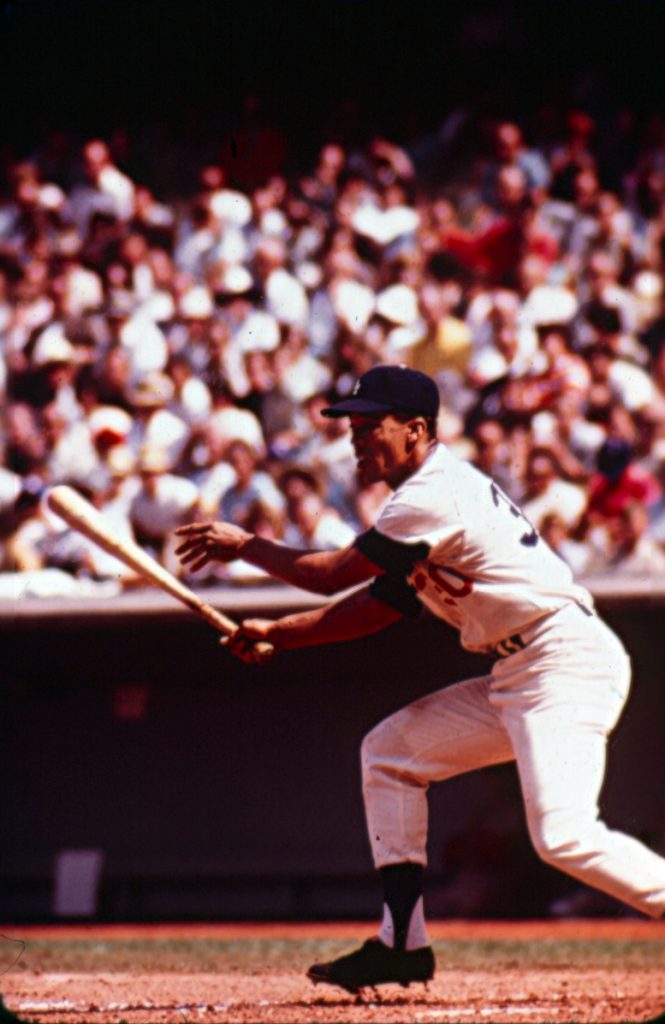 “I shared with them the importance of taking care of themselves off the field, get their rest. Lack of rest beats an athlete down more than anything. All distractions are gonna be there for you, but you gotta make sure you get your rest. I got personal enough, I opened up enough to them to be honest enough to tell them, ‘I got 2,034 hits, six times All-Star, but I cheated myself by at least a third because I could have gotten more rest. So I’m a witness to it, that lack of rest. It works against ya.
“I shared with them the importance of taking care of themselves off the field, get their rest. Lack of rest beats an athlete down more than anything. All distractions are gonna be there for you, but you gotta make sure you get your rest. I got personal enough, I opened up enough to them to be honest enough to tell them, ‘I got 2,034 hits, six times All-Star, but I cheated myself by at least a third because I could have gotten more rest. So I’m a witness to it, that lack of rest. It works against ya.
“I know I had their attention, because I kept looking at them. You didn’t hear a chair move. … I mentioned Ty Cobb’s name, and I was wondering if they would know about Ty Cobb, because he was an inspiration for me. Ty Cobb, my last minor-league game I played, I was on a plane to join the Dodgers in Milwaukee. And I had had a good night the night before; I was in Phoenix, playing Triple-A. I got a newspaper and in the article, Ty Cobb was quoted as saying, ‘I like the way that kid slides,’ talking about me. And it just lifted me up.
“Two years later, in 1962 — this was ’59 — in ’62 I broke his record, so I had to read his book. And I sharpened my spikes, too. … He had a reputation of being a rough-and-tough guy, spiking people. I spiked just as many people as Ty Cobb. Because in his book, he said everybody he spiked had it coming, and I identified with that. Because I got bruises all over me. They’d block the base on me, because I’m a little guy, put a knee on me, hit me right in here, tighten it up, and it hurts. So I shared all this kind of stuff with ’em. I had their attention, I think.
“In this stadium right here, 53,000 people would come alive if I was on first base: ‘Go! Go! Go! Go!’ And the word downtown was, ‘I guess Maury’s on first.’
“At my car when I came out, we weren’t fenced in like the players are today. … We parked right out among the fans. Kids be lined up, they used to be all over me. I got an orderly line up, according to height — you never saw so many tall kids get short all of a sudden. And I would stay there to sign them all. This is 2014; in this I’m going back to about 1963, this ringing in my ear right now, I can hear, as plain as day. I had gone to the Reserved Level, trying to hide my car, and when I got out there, they were lined up, because they had gotten wind of it. They were, ‘He’s up here! I got the car!’ So I started signing, there was five little kids, the fifth kid said, ‘You don’t have to shove — he’ll stay until he signs them all.’ I said, ‘Wow.’ And I did. That just hit me right here, to this day.
“I learned that people like you not so much for how good you are at what you do, but for what kind of person. More of us athletes need to know that, because when to be good at what we do, we get full of it. And I can’t say I wasn’t full of it sometimes myself, but I learned along the way. When those kids were lined up, they helped me to learn that what kind of person you are is what really matters.”
Congratulations, all too late, to Ron Santo on his Hall of Fame election today.
- Buster Olney of ESPN tweeted that “representatives for Clayton Kershaw have had early contact with the Dodgers about a long-term deal, but no serious talks have taken place.”
- The Dodgers 2012 Spring Training schedule is official, starting with a March 5 opener against the White Sox at Camelback Ranch. The final game will be April 1 against Arizona.
- Dodger outfielder Jamie Hoffmann has been claimed on waivers by the Rockies, an indication that the team might be close to singing another major-leaguer. Aaron Harang is a name being bandied about. (Remembering 2011: Jamie Hoffmann)
- Ken Gurnick of MLB.com recaps some recent Dodger minor-league contract signings: Jose Ascanio, Jeff Baisley, Wil Ledezma, Shane Lindsay and (almost official) Alberto Castillo.
- Gurnick also writes that “Ronald Belisario, not seen by the Dodgers since 2010, is again working on obtaining a work visa that would allow him to return to the United States and compete for a Dodgers bullpen role next season.”
- John Sickels of Minor League Ball released his Dodger prospect top 20.
- Bill Buckner is another name being discussed for a Red Sox coaching position under Bobby Valentine, according to Gordon Edes of ESPNBoston.com.
New Red Sox manager Bobby Valentine wants to add Bill Buckner to his coaching staff and the former Boston first baseman wants the job, but the team’s front office is resistant to the idea, a source close to Buckner said.
Valentine and Buckner have been friends since 1968, the year they were both drafted by the Dodgers — Valentine in the first round, Buckner in the second.
“I’ve watched his kids grow up and I respect his every opinion, in baseball and in worldly matters,” Valentine said at his introductory press conference last week in Boston.
“Whether or not Bill Buckner would be on the staff is a decision that Ben (Cherington, the Boston general manager) will talk about or if anybody else is going to be on the staff, Ben and I will talk about it.
“It’s not about friendship, it’s not about who was here in the past, it’s about who can do the specific jobs that need to be done.” …
- Walter Alston would have turned 100 last week, and Howard Cole of Dodgers Blog at the Register commemorated the occasion.
When Hiroki Kuroda chose not to waive his no-trade clause at the end of July, it left one of his leading suitors, the Boston Red Sox, scrambling.
The Red Sox ended up picking up Erik Bedard from Seattle in the three-team, seven-player deal that sent Tim Federowicz and Stephen Fife to Los Angeles and Trayvon Robinson to Seattle. And then … well, let Gordon Edes of ESPNBoston.com tell the story.
Tonight’s forecast: Gloom.
And that’s just the weather (scattered thundershowers, 60 percent chance of rain).
It isn’t much better for the Red Sox, who are left with no choice Tuesday but to rely on Erik Bedard, a sore-legged pitcher whose appetite for the big stage has been openly questioned by a former employer, to keep them alive for a playoff spot that should never have been in jeopardy. …
Bedard came back from a 16-day absence because of a strained lat and sore knee last week against the Orioles and lasted just 2 2/3 innings, needing a staggering 51 pitches to record those two outs in the third. The Red Sox will need much more from him Tuesday night.
Boston has surrendered a 10-game lead in the American League wild card race, thanks in large part to a 7.26 ERA for their starting pitchers in September, Edes notes.
Kuroda has a 3.29 ERA since the trade deadline, though it’s 4.18 in a September that has seen him have neck problems. Perhaps going to Boston wouldn’t have helped, but I’m guessing the Red Sox would be happy to have him pitching on the East Coast tonight instead of for the Dodgers in Arizona.
* * *
- I’m a little concerned with the talk that Don Mattingly might have Matt Kemp bat leadoff to increase his chances (rather slightly, I’d say) of reaching 40 homers and 40 steals. It could spread the impression for potential Most Valuable Player voters that Kemp’s numbers were more of a gimmick in games that weren’t serious. Probably doesn’t matter much either way, but I’d leave Kemp at No. 3 and take his chances there.
- Meanwhile, when they talk about a player’s body in “Moneyball,” I don’t think they mean this.
- David Schoenfield of ESPN’s Sweet Spot asks if Kemp is having the greatest season ever by a Los Angeles Dodger position player.
… According to Baseball-Reference WAR, his season ranks only behind Adrian Beltre’s 48-homer season in 2004, and just ahead of Mike Piazza’s 1997. In fact, forget limiting it to just Los Angeles. The only Brooklyn Dodger seasons that rate higher are two from Jackie Robinson, in 1949 and 1951.
- Today is the 75th anniversary of longtime Dodger manager Walter Alston’s one and only at-bat in the majors, writes Chris Jaffe of the Hardball Times.
… on Sept. 27, 1936, he was just a young 24-year-old hoping to get his shot. He was a bit old for a prospect because he’d gone to college and only went pro after graduating.
In the minors Alston showed promise, hitting over .300 with power in the St. Louis farm system, but there was a big problem. He played first base for a team that already had Johnny Mize. Four times Alston would lead his league in homers, but there was no place for him in the majors. And the more the years went by, the less the aging Alston seemed like a prospect. …
- Russ Mitchell is having season-ending wrist surgery today, the Dodgers said. He is expected to play winter ball.
- A tight hamstring is expected to keep Rafael Furcal on the sidelines for the final two games of the Cardinals’ playoff push.




